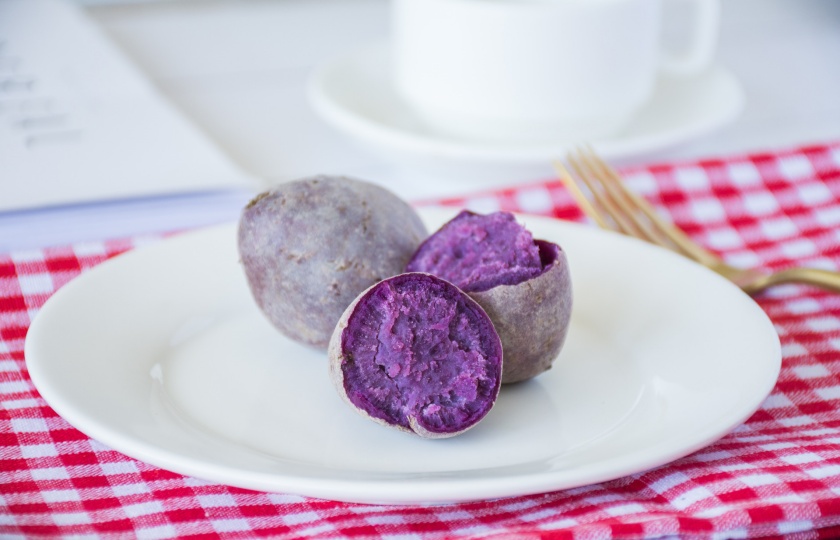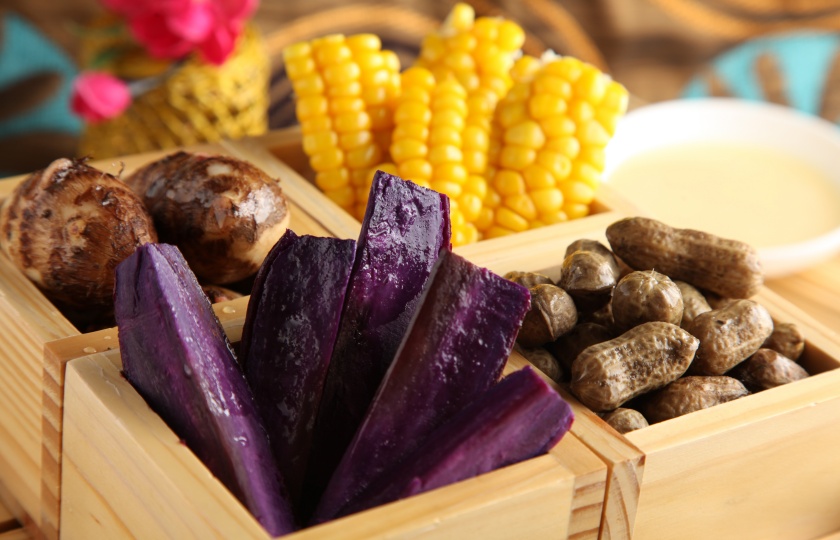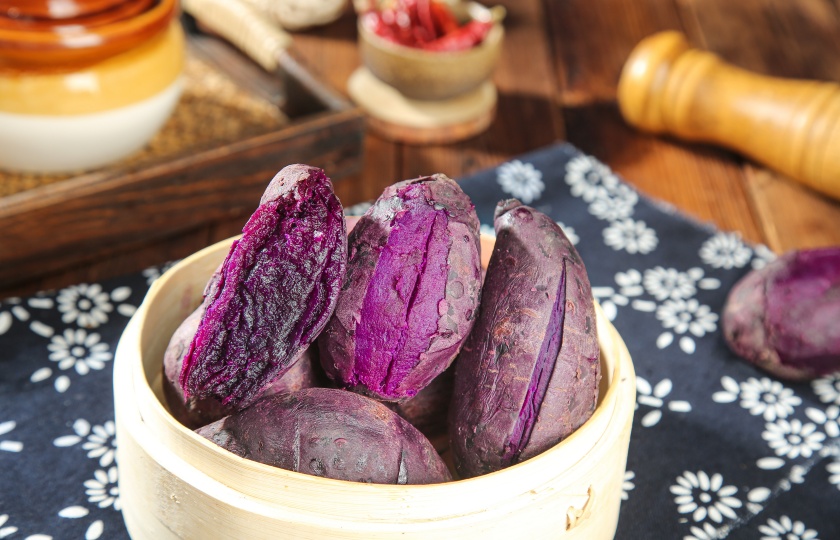Wondering why your purple sweet potato is white inside? Here's why

The purple sweet potatoes I bought at the market and cut at home were actually white inside. After consulting the materials, I found that this is not strange. Today, let's talk about why the inside of my purple sweet potato is white?
Why is my purple sweet potato white inside?
In fact, it is not an abnormal phenomenon for the inside of purple sweet potatoes to be white. The reason why most purple sweet potatoes we see in life are white is because purple sweet potatoes contain a large amount of natural pigment - anthocyanins. Anthocyanins are more concentrated in the skin and some flesh of purple sweet potatoes. However, the color of the inner pulp of purple sweet potatoes is affected by varieties, planting environments and growth cycles. The interior of some purple sweet potato varieties may be white or light yellow.
Secondly, if the purple sweet potato is not fully mature, the inside may also be white. Because the accumulation of anthocyanins has not reached the most ideal state, so the purple sweet potato looks like an ordinary white sweet potato. Purple sweet potatoes in different regions, planted in different ways, and even under different climatic conditions will also have different colors.
In addition, storage conditions will also have an impact. If the temperature and humidity during storage are inappropriate, purple sweet potatoes will undergo physiological changes, resulting in the decomposition of internal sugar and anthocyanins, and the color will become lighter or even turn white.
Why is my purple sweet potato brown inside?
The inside of purple sweet potatoes being brown may be caused by the following reasons:
First, it may be caused by oxidation. Purple sweet potatoes are rich in a large amount of anthocyanins. When the inside of purple sweet potatoes comes into contact with air, anthocyanins will undergo an oxidation reaction. Just like apples will change color after being cut, the inside of purple sweet potatoes may also turn brown for this reason. Especially when purple sweet potatoes are cut or damaged, this oxidation will occur more rapidly, which is a normal situation.

Secondly, it may be that purple sweet potatoes are affected by certain environmental factors during the growth process, resulting in internal discoloration. For example, if purple sweet potatoes encounter changes in soil composition, pest attacks or extreme climatic conditions during the growth period, the internal components may change, and then turn brown.
The last reason is improper cooking or storage methods. If the temperature is too high and the time is too long when cooking purple sweet potatoes, or if the temperature and humidity are inappropriate when storing purple sweet potatoes, there is a probability that the internal color of purple sweet potatoes will change and appear brown.
What should inside of purple sweet potato look like?
Under normal circumstances, the inside of purple sweet potatoes is usually purple or light purple.
The inside of most purple sweet potatoes is dark purple. This is due to the anthocyanins rich in purple sweet potatoes. Anthocyanins are a natural pigment. The color will change in different acid-base environments, but in purple sweet potatoes, it is a relatively rich dark purple.
However, there are also some special varieties of purple sweet potatoes. The inside may be light purple, and even a little white on some edge parts. Just like the difference between purple-hearted and white-hearted purple sweet potatoes commonly seen in life. The central part of white-hearted purple sweet potatoes is relatively light in color, which is a normal variety characteristic.
In addition, during the growth process of purple sweet potatoes, if affected by factors such as light and soil nutrition, the depth of the internal color may also fluctuate. For example, purple sweet potatoes with sufficient light have more anthocyanins synthesized, and the internal color will be deeper and more vivid; if some elements are lacking in the soil during the growth process, the color may be a little lighter.
How do I know if my purple sweet potatoes have solanine?
You can judge whether purple sweet potatoes contain solanine through the following points:
Look at the color
Normally, fresh, mature and properly stored purple sweet potatoes with good quality have extremely low solanine content and will not cause harm to the human body. If purple sweet potatoes sprout or turn green, their solanine content will increase.
Smell the smell
Normal purple sweet potatoes smell of a faint sweet potato fragrance. If they smell sour, stinky or other strange odors, it means they have deteriorated and may contain harmful substances such as solanine.

Taste the taste
Good purple sweet potatoes taste soft, glutinous and sweet. If there is a bitter, musty or other abnormal taste, it means that the purple sweet potato has deteriorated and it is not recommended to eat it again.
Use professional detection methods
High performance liquid chromatography (HPLC): Professional detection methods can also be used to accurately detect the solanine content in purple sweet potatoes.
Inductively coupled plasma mass spectrometry (ICP-MS): This method is suitable for detecting heavy metal elements in purple sweet potatoes, such as lead, cadmium, arsenic, etc., but it can also be used to detect other harmful substances.
Do you eat the skin of purple sweet potatoes?
The skin of purple sweet potatoes can be eaten.
Not only can the skin of purple sweet potatoes be eaten, but it also has a high content of nutrients. It contains a large amount of vitamins, dietary fiber, anthocyanins and other substances, which can promote the peristalsis of the human gastrointestinal tract and is beneficial to human health.
If you want to eat the skin of purple sweet potatoes, pay attention to cleaning the purple sweet potatoes to avoid pesticide residues or contamination on the skin.
The taste of the skin of purple sweet potatoes is not particularly good. In life, people always peel it off. Especially for some older purple sweet potatoes, the skin tastes rougher.
Which color sweet potato is healthiest?
There are actually many kinds of sweet potatoes. The nutritional components of different kinds of sweet potatoes are different. Common sweet potato varieties are orange, purple and yellow. Strictly speaking, there is no saying which one is the healthiest. You can choose according to your personal needs. The details are as follows:
Orange sweet potato
Orange sweet potatoes are the most common. They are rich in beta-carotene, which helps protect eye health, enhance immunity and is beneficial to the skin. It is also an excellent source of vitamin A, which helps maintain skin health and vision.
Purple sweet potato
Purple sweet potatoes are rich in anthocyanins, which have antioxidant and anti-inflammatory effects and are beneficial for preventing cardiovascular diseases, enhancing immunity and anti-aging. It is a very healthy choice, especially suitable for friends who pay attention to antioxidant and anti-aging.

Yellow sweet potato
Yellow sweet potatoes are rich in carotenoids, which have good health care effects on eye health and also have antioxidant effects. The taste is more delicate and soft than orange sweet potatoes, suitable for people who like a delicate taste.























